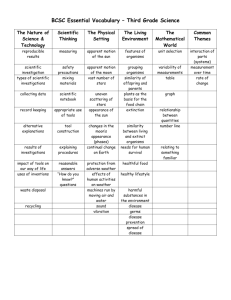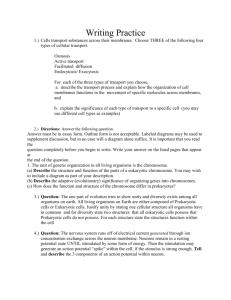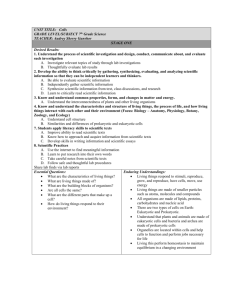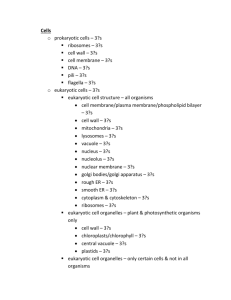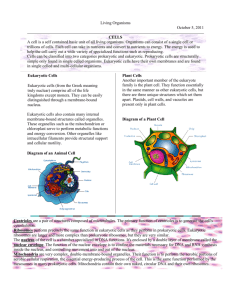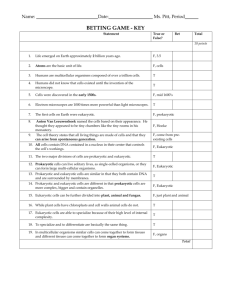More
advertisement
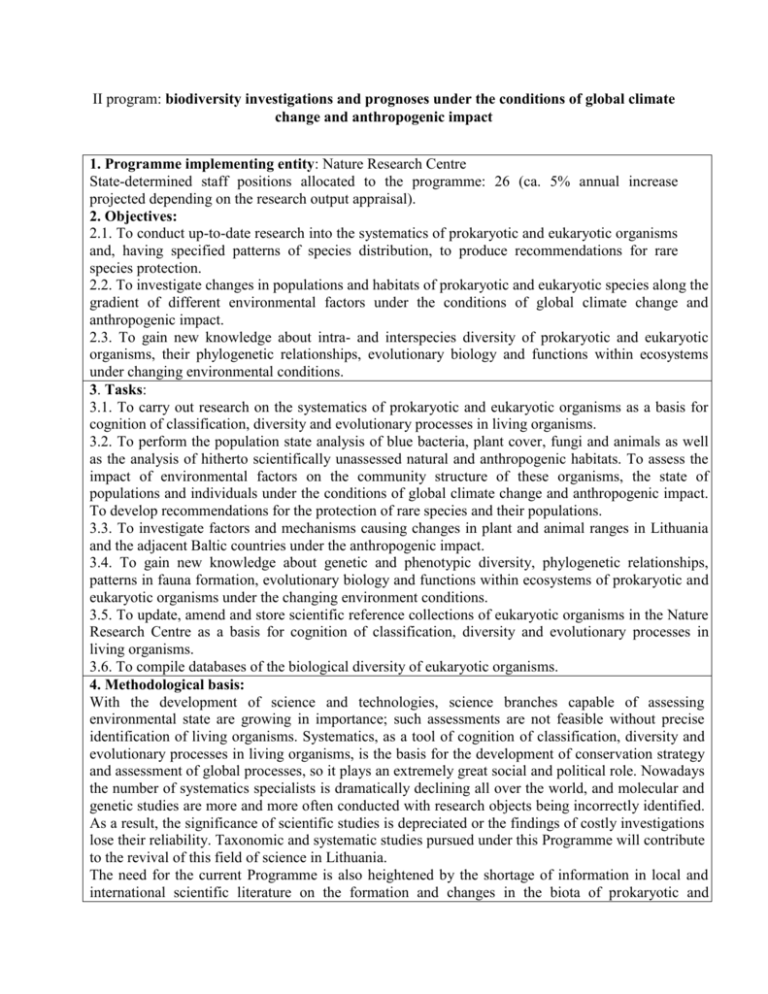
II program: biodiversity investigations and prognoses under the conditions of global climate change and anthropogenic impact 1. Programme implementing entity: Nature Research Centre State-determined staff positions allocated to the programme: 26 (ca. 5% annual increase projected depending on the research output appraisal). 2. Objectives: 2.1. To conduct up-to-date research into the systematics of prokaryotic and eukaryotic organisms and, having specified patterns of species distribution, to produce recommendations for rare species protection. 2.2. To investigate changes in populations and habitats of prokaryotic and eukaryotic species along the gradient of different environmental factors under the conditions of global climate change and anthropogenic impact. 2.3. To gain new knowledge about intra- and interspecies diversity of prokaryotic and eukaryotic organisms, their phylogenetic relationships, evolutionary biology and functions within ecosystems under changing environmental conditions. 3. Tasks: 3.1. To carry out research on the systematics of prokaryotic and eukaryotic organisms as a basis for cognition of classification, diversity and evolutionary processes in living organisms. 3.2. To perform the population state analysis of blue bacteria, plant cover, fungi and animals as well as the analysis of hitherto scientifically unassessed natural and anthropogenic habitats. To assess the impact of environmental factors on the community structure of these organisms, the state of populations and individuals under the conditions of global climate change and anthropogenic impact. To develop recommendations for the protection of rare species and their populations. 3.3. To investigate factors and mechanisms causing changes in plant and animal ranges in Lithuania and the adjacent Baltic countries under the anthropogenic impact. 3.4. To gain new knowledge about genetic and phenotypic diversity, phylogenetic relationships, patterns in fauna formation, evolutionary biology and functions within ecosystems of prokaryotic and eukaryotic organisms under the changing environment conditions. 3.5. To update, amend and store scientific reference collections of eukaryotic organisms in the Nature Research Centre as a basis for cognition of classification, diversity and evolutionary processes in living organisms. 3.6. To compile databases of the biological diversity of eukaryotic organisms. 4. Methodological basis: With the development of science and technologies, science branches capable of assessing environmental state are growing in importance; such assessments are not feasible without precise identification of living organisms. Systematics, as a tool of cognition of classification, diversity and evolutionary processes in living organisms, is the basis for the development of conservation strategy and assessment of global processes, so it plays an extremely great social and political role. Nowadays the number of systematics specialists is dramatically declining all over the world, and molecular and genetic studies are more and more often conducted with research objects being incorrectly identified. As a result, the significance of scientific studies is depreciated or the findings of costly investigations lose their reliability. Taxonomic and systematic studies pursued under this Programme will contribute to the revival of this field of science in Lithuania. The need for the current Programme is also heightened by the shortage of information in local and international scientific literature on the formation and changes in the biota of prokaryotic and eukaryotic organisms in Lithuania and neighbouring countries. Hence, the fundamental outcome of this project will be the extension of knowledge of prokaryotic and eukaryotic organisms not only in Lithuania, but abroad as well. Assessment results of alien species invasion into the Baltic region and the shift of indigenous species range will be applied to the development of Lithuanian biota protection, strategies and prognosis of the state of economically significant populations. Theoretically significant will be the development of species diagnostics methods and the assessment of causes and consequences of global climate change, habitat changes and anthropogenic impact as well as further prognoses of biota diversity changes in Baltic countries. Advanced DNA analysis methods (PCR technologies, sequencing, identification and analysis of gene sequences), innovative laser microscopy as well as traditional methods (morphological, karyological, histological, light and electronic microscopy) will be used in investigations of prokaryotic and eukaryotic organisms. The research will be pursued integrating cutting-edge molecular technologies with advanced geographic information system (GIS), experimental, ecological and morphological investigation methods. Such interdisciplinary investigations of organisms will be carried out in Lithuania for the first time. The Nature Research Centre boasts the conditions and facilities indispensable for conducting the envisaged scientific research investigations. Owing to the funding received from the Lithuanian State Science and Studies Foundation, the Lithuanian Government and foreign foundations (NATO, USA National Science Foundation and others), laboratories were outfitted for the application of PCR-based DNA analysis methods in such fields of study as botany, zoology and ecology. These conditions are going to be upgraded in the near future having absorbed additional funds allocated by EU and the Lithuanian Government. The Nature Research Centre takes part in the implementation of Santara Valley Programme, which integrates the potential of Lithuanian research, studies and business and is funded by the European Union (EU) and the Lithuanian Government. Over the 2008–2013 period, the Programme has been allocated a total of 67,9 million litas for the acquisition of state-of-the-art laboratory equipment (gel documentation and electrophoresis system Lab901 UK, automated micronuclear analysis system, automated cell image analysis platform, automated colony counting and assessment system, microscopy system, equipment for high-pressure liquid chromatography, National herbarium (BILAS,WI) depository equipment, the complex of inserting and amending equipment, genetic analyser ABI 3130, etc.), which has added a new impetus for the development of fundamental and applied fields of biomedicine in Lithuania. This equipment will be useful for the implementation of the current programme. 6. Expected Outcomes: The main research tasks under the current Programme address fundamental issues in ecology, protistology, botany, mycology, microbiology, zoology and parasitology, the settlement of which will help gain the basic knowledge about intra- and interspecies diversity of prokaryotic (blue bacteria) and eukaryotic (protists, plants/flora, fungi, invertebrates and vertebrates) organisms, its state, the phylogeographic history of species, peculiarities of population formation and possible changes in ecosystems under the effect of global climate change and anthropogenic activity. The results obtained will be significant for determining stability mechanisms of the Baltic region biota. The gained basic knowledge will deepen the understanding about formation and functioning of ecosystems in Baltic countries, will help implement purposive nature protection programmes and predict possible changes. The major part of research results will be published in international journals, whereas collected material and genetic information will be deposited in Lithuanian and international parasite collections as well as in the International Gene Bank. One of considerable gains from the current Programme will be a great amount of sequenced genetic material derived from eukaryotic parasites. Such information will be useful to biology scientists all over the world when conducting comparative genomic investigations of eukaryotic organisms. The current Programme will contribute to the development of ecology, botany, mycology, microbiology, zoology, parasitology and evolutionary biology not only in Lithuania but also all over the world. Depositories of eukaryotic organisms of the Nature Research Centre will be enriched with valuable research material. The Programme will greatly contribute to the process of student education and training. Would-be researchers and scientists (1st, 2nd and 3rd- level students and post-doctoral interns) will be invited to take part in innovative scientific investigations as well as in fieldwork and laboratory work activities. The current programme is expected to provide impetus for the preparation of approximately 10 doctoral theses. The recently established Nature Research Centre as an institution carrying out world-class investigations into systematics, ecology and evolutionary biology of prokaryotic and eukaryotic organisms in Lithuania is expected to benefit considerably from the current Programme. Findings of the investigations conducted under the programme will increase public awareness of the nature research pursued in Lithuania. The following results are expected to be achieved as a result of the current programme implementation: 1. New to science species of protists, fungi and animals will be described and the most suitable phenotypic and molecular markers for their identification will be determined. New species and their strains, type material and molecular markers will be registered in international collections and databases. The systematics of these organisms, indispensable for the identification of living organisms and for the assessment of the ecological state of the environment will be developed. 2. The knowledge about the distribution, genetic and phenotypic diversity, life cycles, biological properties and molecular diagnostics of prokaryotes, protists, fungi, plants and animals of the Baltic region will be extended. The gained knowledge will be used for settling problems pertinent to biodiversity protection and for theoretical substantiation of investigations of biological resources. 3. The information on new, hitherto unknown in the country and/or the Baltic region species of organisms will provide additional data on the richness of biodiversity as well as on potential economically significant species. The number of sampling locations of rare and protected species will be specified, which will broaden the knowledge indispensable for the management of areas, especially those that are protected. Moreover, this information will help specify the network of protected species habitats, optimise protection of these areas, thus safeguarding survival of rare species. 4. The general classification scheme of natural and anthropogenic habitats of Lithuania will be developed, the composition of the Lithuanian flora of vascular plants, moss and Charophyceae species will be specified, new taxonomic inventories of Lithuanian vascular plants and moss will be published and the Lithuanian flora of Charophyceae species will be described, the BRAHMS herbarium database integrated with GIS functions will be installed. Investigation findings will make it possible to plan further precise investigations into plant cover in Lithuania. 5. The planned investigations are expected to reveal changes in the biodiversity of particular invertebrate groups and species, their habitat specificity, seasonal variations, habitat colonization and isolation rates, interrelationships of plant and invertebrate complexes, the impact of climate change and soil-forming processes on the development of natural complexes, which help understand and assess formation mechanisms of invertebrate complexes, specificity, colonization rate and dependence on habitat change and climatic parameters. 6. The inventory of the Palearctic fauna of moth species in diversity centres, in fragmentary and degraded habitats will be compiled, investigations of fossil and recent mosquitoes of the tipuloid complex will be carried out. The taxonomic position of fossil insects of the superfamily Tipuloidea from Dominican and Mexican amber will be studied and generalized. Investigations of Baltic amber will be continued with the description of new taxa in the focus of attention. The taxonomic composition, distribution of particular species, dynamics of the infraorder Tipulomorpha from the Eastern Palaearctic (Mongolia in particular) as well as the possibility of using its specimens for bioindication will be explored. 7. Investigations into species diversity and succession of phytoplankton and phytobenthos will make it possible to carry out the ecological assessment of water bodies, substantiate recommendations for the mitigation of adverse anthropogenic impact. The importance of biological properties, life cycle and strategies of particular organisms as well as the importance of abiotic and biotic factors for the establishment of species will be assessed, focusing on algal bloom in water bodies under the conditions of global climate change and anthropogenic impact. Disclosure of water bloom mechanisms will help assess adaptive abilities of certain organisms, predict trends in “bloom” development, thereby safeguarding human life quality, ensuring effective protection of hydrosystems and thus implementing the strategy for harmonious development of national aquatic ecosystems. 8. Findings of investigations into communities of aquatic organisms (fish and benthic invertebrates) will allow researchers to predict changes in species distribution and survival possibilities in case of one or another environmental change scenario, will help assess possible consequences of interspecies competition under the conditions of environmental change, will enable researchers to assess the state of aquatic communities in different regions and on a national scale. That will create preconditions for enhancing efficiency of aquatic animal species protection and that of population management and, thereby, for rational management of water bodies. Investigation findings will allow researchers to exactly identify risk factors and choose the most suitable mitigation measures for specific localities or problematic regions. 9. The most significant factors affecting parameters of bird and mammal populations (population dynamics, spatial distribution, structure, migrations) and mechanisms of population regulation, formed as a result of interaction of these factors, will be determined. Target results: extension of the knowledge of regularities in bird migration as well as that of bird and mammal fauna development not only in Lithuania but in other Baltic countries as well. Theoretically significant result: assessment of causes and effects of the impact induced by global climate change, habitat changes and anthropogenic activities. Prognoses of changes in bird and mammal diversity in Baltic countries will have practical significance. 10. Investigation findings will make it possible to assess and predict the impact of various economic activities (agriculture, forestry, fishery) and long-term climate change on various fungi, plant and animal species. Established regularities will be applied to boosting efficiency of endangered species protection, to the development of measures for the mitigation of impact induced by long-term climate change and economic activities as well as to the development of management of fungi, plant and animal species populations, including problematic ones. 11. The knowledge about specificity and virulence of parasitic eukaryotic organisms (sporozoans and helminths) in the Baltic region and diseases caused by these widespread parasites will be extended. Routes and mechanisms of parasite species migration and spreading will be disclosed. The assessment of the significance and possible consequences of these processes for the Baltic region, its economy and health of human beings will be made. 12. The phylogeographic history of model eukaryotic species, peculiarities of population formation and possible changes in ecosystems under the conditions of global climate change and anthropogenic impact will be analysed and determined. The new information will lead to a better understanding of ecosystem functioning, the possible change forecasting and to rational management of renewable resources. These investigations have long-term prospects. The knowledge of phylogeographic patterns of the Baltic region is significant not only for investigations into the history of European biota, but also for studies of the general formation of the Holarctic fauna and flora. As the Baltic region hosts quite a number of palearctic and even holarctic species, the study material from the western Palearctic may be of great importance for the investigation of genetic differentiation, evolution and phylogeography of distant populations. Undoubtedly, Lithuanian scientists will be able to take part in such investigations in the near future. 13. Reference scientific collections of eukaryotic taxa and biodiversity databases of the Nature Research Centre will be inventoried. These collections will be readily accessible to students and scientists of Lithuania and other foreign countries. These collections form the mandatory basis both for taxonomic research on a global scale and for the assessment of change in biota diversity on a national scale. 14. Approximately, 90 WoS articles are going to be published (on average, 18 articles per year). 15. The following books will be prepared for press and/or published: 1st book, Series “Lithuanian fungi” Identification keys for crane flies (Diptera: Cylindrotomidae, Limoniidae, Pediciidae, Tipulidae) of Mongolia and adjacent territories. The book on crane flies of Mongolia will be used for the inventory of the Holarctic fauna of these insects. Small mammals of Lithuania Atlas of Lithuanian mammals, 3rd extended edition. 9. Programme duration: 2012–2016 10. Chief executive: Dr Habil. Gediminas Valkiūnas, chief researcher, 2729269, 8 682 39056, gedvalk@ekoi.lt


